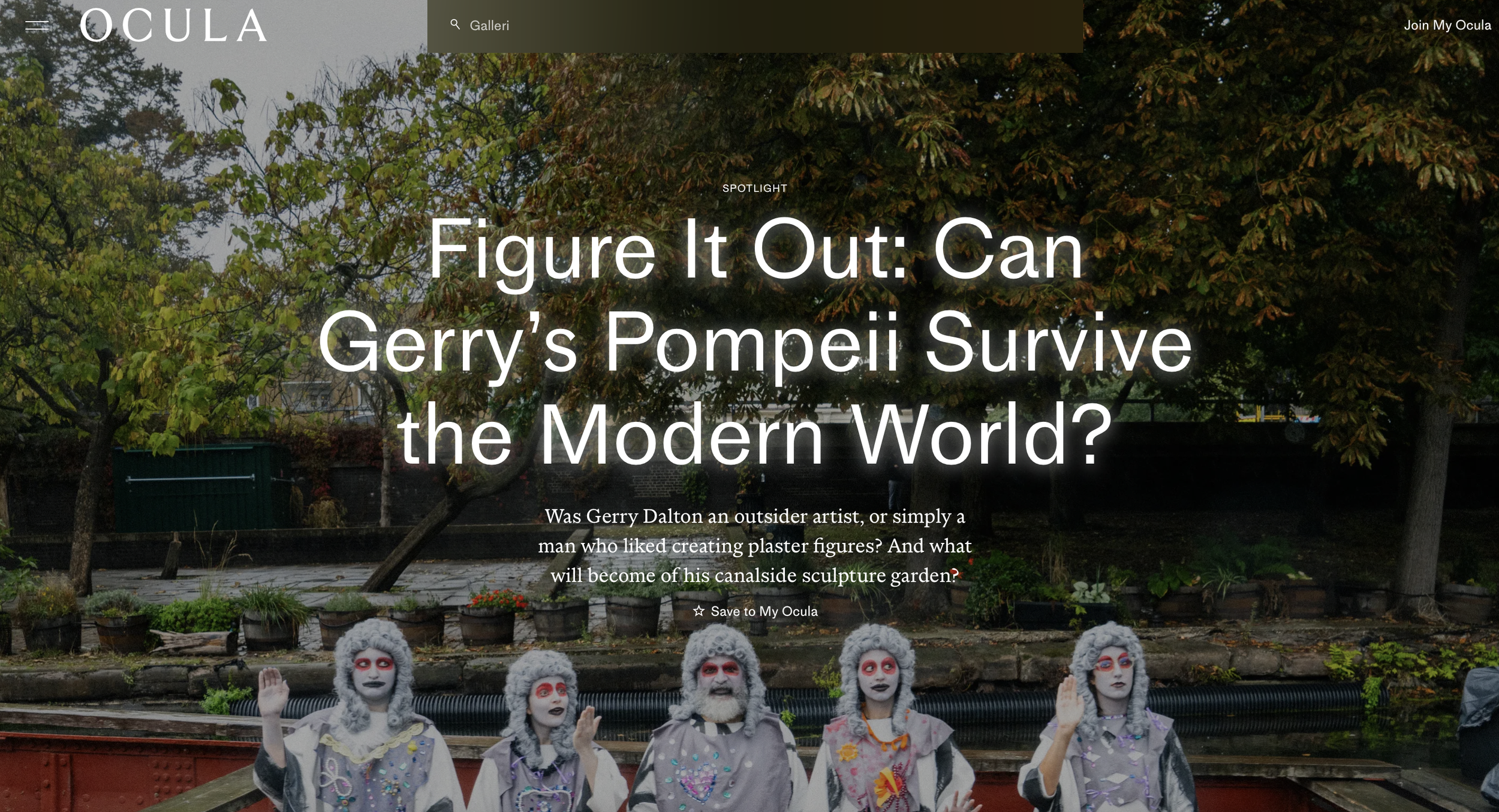By Joe Lloyd – 29 October 2025, London
Read the full Ocula article here.
There is an idyll in the shadow of the Trellick Tower, an icon of Brutalist architecture designed for the Greater London Council by Ernő Goldfinger and first opened as social housing for the local community in 1972. Walk down the Grand Union Canal towpath from Trellick Tower towards central London and across the water you will see a gleaming assortment of colourful plastic gems decorating a wall: peculiar figures with stupendous grey coiffures and red-circled eyes peek out solemnly from beneath it, half-concealed by low hedges.
Look closer, and naïve sculptures of cherubs and buddhas rendered roughly from plaster come into view. A patchwork of tiles shows landscapes and arabesque patterns, while others are plain white bathroom units. Behind this wall are miniature sculptures of the same material standing on rough-hewn concrete plinths, each one with a grey face, wig-like hair and a black-and-white robe stuck with trinkets. They depict British historical figures (Queen Catherine of Braganza, King George I, Prime Minister George Canning) and can be identified not by their appearance but by text scrawled into plaques in the wall above. There is one outlier, with noticeably less hair than his neighbours. His name is given simply as Gerry.
This is Gerry’s Pompeii. For more than 30 years, an Irishman called Gerry Dalton, whose former ground-floor flat at 32A Hormead Road backs on to this canalside sliver of land, would install his sculptures secretly by night. For a while almost no one knew what he was doing: the land was once concealed by higher hedges and piled with bottles, mattresses and other detritus. But then, with the help of his neighbour, Japanese artist Satoshi Kitamura (now an award-winning children’s author), Dalton cleared this away. Not long before his death in 2019, he said: ‘They’ll be astonished by what they’ll find in my garden in years to come. It’ll be like Pompeii or something.’
On an overcast afternoon in late September, several hundred fans, artists, curious bystanders and neighbours processed along the canal beside a boat filled with performers dressed up as Dalton’s sculptures. The living statues languidly imitated the motions of individual spectators in stony slow motion, whether raising a phone or scratching a nose, before bursting into occasional synchronised movements to blasts of choral music. This was Gerry’s Gongoozling (a gongoozler is a person who enjoys watching canal activity), the latest in a long-running series of events organised by an ongoing campaign to preserve and remember the life and work of Dalton, led by curator Sasha Galitzine. The parade began at Paddington Basin (Dalton worked for a period as a night postal porter at Paddington station), headed west and ended at his garden.
The assembled crowd was greeted at intervals by performances by a samba band, a troupe of actors dressed as canal rats, and puppets floating over the water. In a performance conceived by the artist Amalia Pica, a series of lone figures stood on a succession of bridges waving handkerchiefs coloured by natural dye, made in a workshop by residents of a nearby care home. A musical troupe, clad in back-to-front denim outfits, serenaded passersby with surreal ditties. Performance artist Philip Ewe periodically appeared across the canal to perform absurdist spoken word pieces. Saxophonist James Cockling played a rousing solo from a balcony at a final stop just above Dalton’s creations…..






